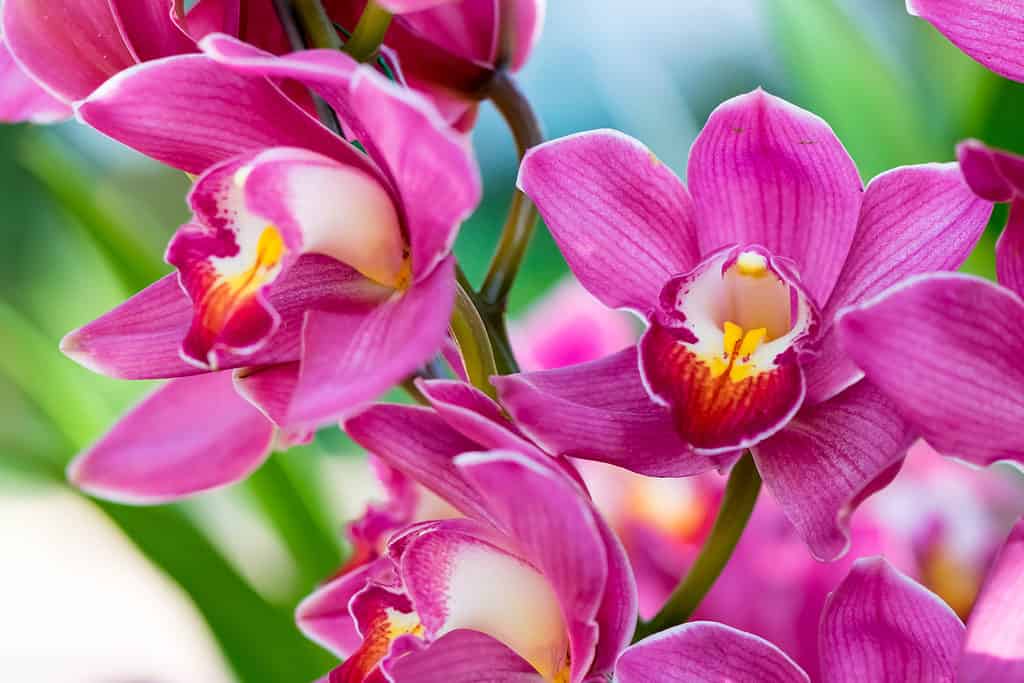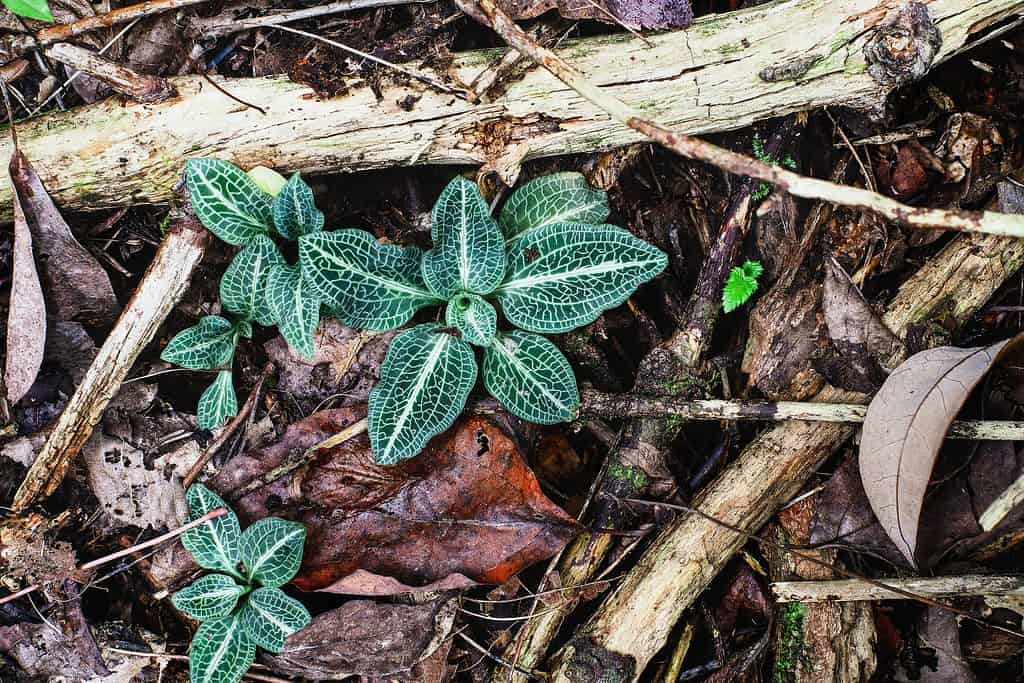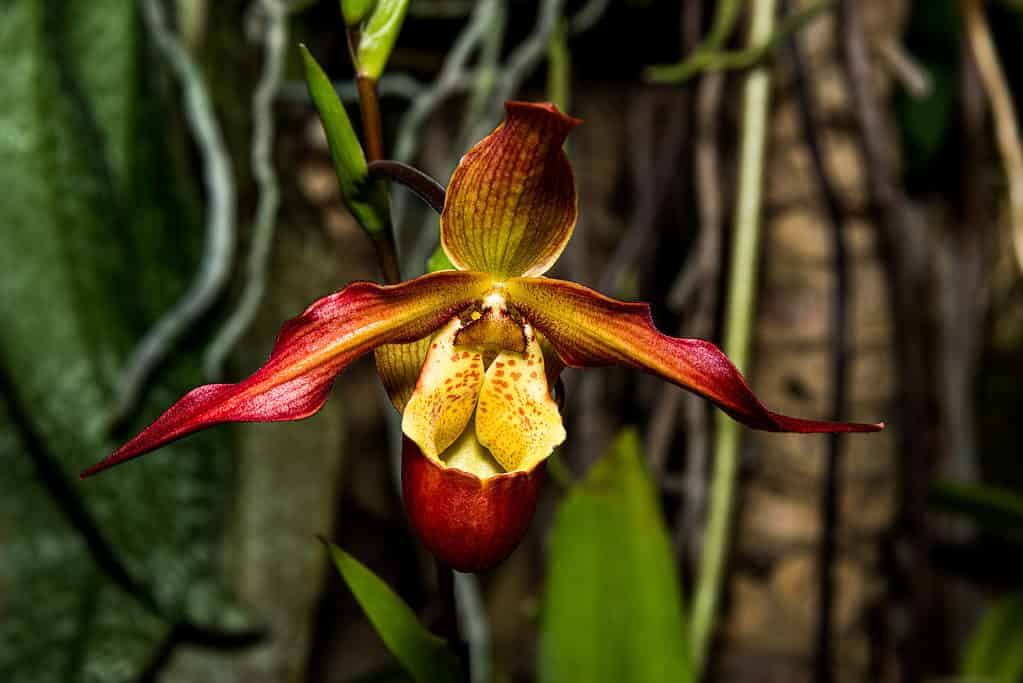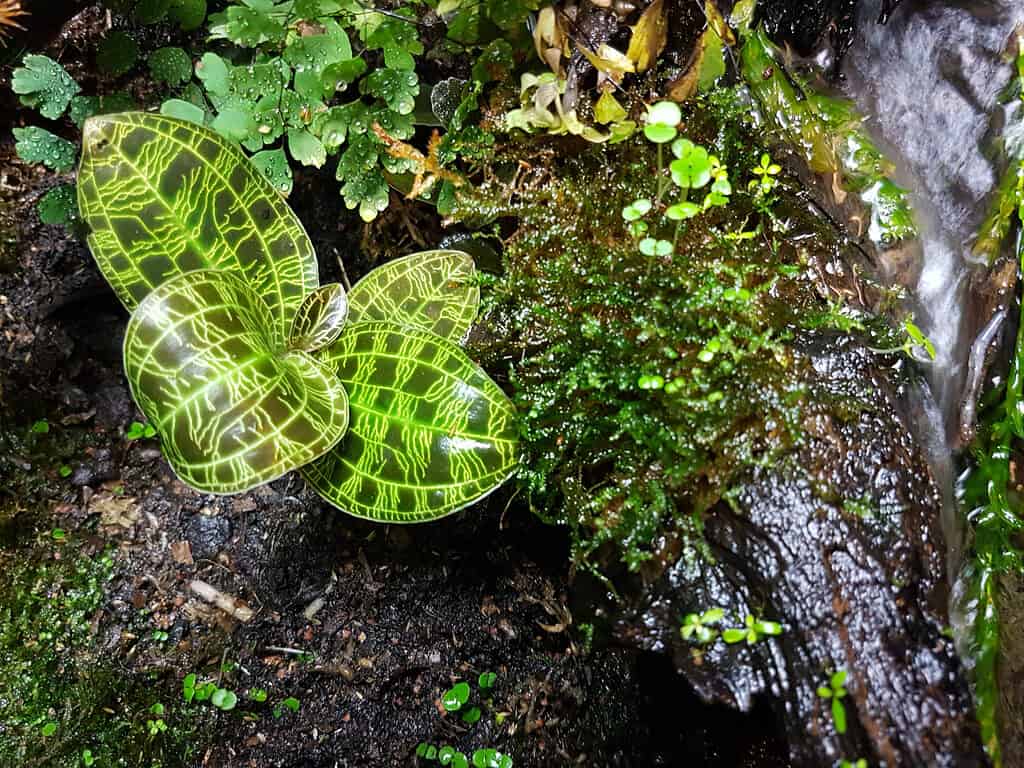Given the incredible diversity of orchids, it’s no surprise that stunning variegated species exist. In fact, there are hundreds of orchid species with leaf or petal variegation. If you’re a fan of collecting orchids, adding these multi-colored, multi-patterned varieties will only add to the beauty of your collection.
In this guide, we’ll briefly cover the orchid family. We will also discuss how the variegation of plants occurs and describe four types of variegated native and cultivated orchids.
Let’s get to it!
Orchids: Plant Classification and Origin
Orchids belong to the Orchidaceae botanical family, the world’s second-largest family of flowering plants. This massive plant family currently contains over 28,000 species of orchids divided into about 880 genera. Highly diverse and adapted to various climates, native species of these plants grow on every continent except Antarctica. Botanists have traced back orchids’ appearance on Earth to about 112 million years ago. Orchids spread from an origination point likely in Asia’s far South tropical regions.
Broadly speaking, two main growth habits of orchids place them into two categories. Either terrestrial (land-based) species or epiphytes. Epiphytes mean they attach their roots to the structure of another plant rather than growing in the soil. Out of the nearly 30,000 orchid species, only about 200-300 are terrestrial. When they first emerged 112 million years ago, all orchids were terrestrial. However, the species evolved over millions of years, and by 35 million years ago, the majority of species were epiphytes. Today, roughly 80% of all orchid species grow attached to trees. Their roots are exposed to the air, where they obtain most of their water intake through fog and rain. In fact, this evolution from terrestrial to epiphyte increased their diversification by over 20%!

Orchids belong to the Orchidaceae botanical family, the world’s second-largest family of flowering plants.
©Joy Baldassarre/Shutterstock.com
Common Features of Orchids
Thankfully, identifying a plant as a member of the orchid family is rather achievable. Across the world, all orchid flowers are comprised of the same four main parts:
- Two petals make up the inner layer of the flower. You’ll see these two petals growing outward from the center. They mirror each other in shape and color.
- A third bottom petal is called a lip or labellum. The labellum normally protrudes a bit forward. It is often distinctly colored and patterned to attract pollinators to land on it.
- Three sepals comprise the outer layer of the flower. On orchids, the sepals look rather indistinguishable from the petals. They form the protective layer of the flower bud and open and enlarge when the plant is ready for pollination. The sepals typically mirror each other in shape and size.
- The column protrudes from the center of the flower. It’s a fusion of the plant’s male (stamen) and female (pistil) reproductive organs. This fusion is one of the unique aspects of orchid flower structures.

The third bottom petal on orchids normally protrudes a bit forward and is often distinctly colored and patterned to attract pollinators.
©Sealstep/Shutterstock.com
Variegated Orchids: What Causes Variegation?
Plant variegation, as defined by the University of Massachusetts’s Department of Plant and Soil Sciences, is the presence of “stripes, blotches, and streaks, or by differences in color between leaf (or petal) margins and the leaf (or petal) mid-region.” In orchids, colorful variegation, especially of petals, is often a useful evolutionary feature that can help attract pollinators. Variegation of plants can occur through two main mechanisms: cell lineage variegation and noncell lineage variegation.
The first occurs when more than one genotype exists in the cells of the plant, creating different phenotypic expressions. With cell lineage variegation, some cells contain the genes for pigment expression, while others don’t, regardless of where the cell is located.
In the latter form of variegation, the same genotype exists across the cells, but only some cells express certain pigmentation. Noncell lineage variegation means all cells contain the same genes necessary to produce or destroy certain pigments. What determines this expression is where the cell is located on the structure of the plant rather than gene history.
Variegated Orchids: 4 Gorgeous Species
Below, we’ll discuss four stunningly variegated species that feature unique leaf patterns and coloring. Our list shows that variegated leaves are particularly common with terrestrial orchid species. In fact, one study noted that about 80% of orchids with variegated leaves are terrestrial, which is quite significant considering about 75% of all orchids are epiphytes.
This study posits that the variegated leaves may serve a defensive purpose for the plant. It aids in camouflage, mimicry, or aposematic coloration. Aposematic coloration refers to bright or vivid coloration in organisms designed to prevent predation. You’ll often see this in the type of defensive coloration in amphibians, such as the poison dart frog.
Researchers may not yet know the precise reason for terrestrial orchid leaf variegation, but one thing we know for certain is that it’s stunning. In a nod to the statistic listed above, we’ve listed three terrestrial orchids with variegated leaves and one epiphytic orchid that also displays variegated leaves.
1. Downy Rattlesnake Orchid (Goodyera pubescens)
This orchid is also known as the downy rattlesnake plantain for its leaf resemblance to a miniature plantain plant. It is native to North American orchid and is one of four species in the Goodyera genus. An evergreen perennial, the lovely downy rattlesnake orchid speckles shaded forested areas of Eastern North America.
Morphology
The leaves of this terrestrial orchid are basally oriented, growing outward in a rosette pattern from the base of the main stem. The softly rounded blue-green leaves are covered in fine hairs and are strikingly variegated with fine, silver veins and a stark, thick white center vein. The number of leaves ranges from four to eight and typically mature at 1.5 to 2.5 inches long. You’ll find this gorgeous plant flowering from July to August in the summer. In summer months, it will produce a central, upright raceme with a dense cluster of tiny, white flowers.
Plant Care
Thriving in forests and woodland gardens, Goodyera pubescens develops symbiotic relationships with forest fungi wherein the plant provides sugar to the fungi in exchange for nutrients gathered by the fungi’s mycelium. This forest-loving orchid does best in medium-to-bright, filtered sunlight in fertile, moist, and slightly acidic soils. This plant likes evenly moist but not saturated soil, so water about once per week. If you live in a drier region, it can be helpful to lightly cover the ground surrounding your rattlesnake orchid with a layer of mulch or leaves for better moisture retention.
If you live in a wooded area in this plant’s growing region, you may find it naturally growing. Rather than disturbing this plant by uprooting it, especially in Florida, where it’s considered endangered, it’s best to enjoy it where it’s growing. Instead, you can obtain these plants to grow in your woodland garden through a responsible native plant nursery.

The rattlesnake plantain orchid has blue-green leaves and is variegated with fine, silver veins and a stark, thick white center vein.
©Stephanie Frey/Shutterstock.com
2. Schiller’s Moth Orchid (Phalaenopsis schilleriana)
Belonging to one of the most popular, beginner-friendly orchid genera, schiller’s moth orchid (Phalaenopsis schilleriana) is a member of the Phalaenopsis genus, commonly known as the moth orchids. Like many other moth orchid species, the Schiller’s moth orchid is native to the Philippines. As with the rest of its genus, Schiller’s moth orchid is an epiphyte, its native growing habitat situated high up on rainforest trees at elevations up to 1500 feet.
Morphology
The leaves of these stunning plants are broad, elliptical, and display a gorgeous mottled, striped pattern of dark green bands over a pale grey-green base. Interestingly, many other species within the Phalaenopsis genus also feature variegated leaves.
For the Schiller’s moth orchid, expect the mature leaf length to range from 6-18 inches. Flowering in the spring, Schiller’s moth orchid produces clusters of showy, vibrant pink, white, or light purple flowers along an arching raceme that can reach up to 3 feet long. Flowers of this species can reach up to 4 inches across.
Plant Care
An excellent candidate for growing as a houseplant, you’ll want to mimic this orchid’s natural growing environment as an epiphyte. This particular species is rather adaptable, so you have various options, which can somewhat depend on your region and your climate’s humidity. If you live in a humid region, try opting for a sphagnum moss-based growing medium with lava rock additives. For growers in more arid environments, try a moisture-retaining epiphyte orchid mix such as a peat or medium fir bark-based mix with sponge rock or diatomite additives.
Epiphytes such as Schiller’s moth orchid look stunning as hanging plants. Just make sure to provide bright but indirect light. This type of orchid prefers its growing medium to dry out fully between weekly watering. Water the roots by soaking the bottom of the plant for about 20 minutes, making sure to remove the watering source afterward to allow drainage and the growing medium to dry over the next 5 or so days.
You’ll want to keep temperatures above 55 degrees Fahrenheit for this tropical orchid. During its growing season from spring through summer, fertilize weekly with a 1/4 dose of a balanced orchid fertilizer. Cut back to monthly fertilizing in the dormant seasons.

Schiller’s moth orchid produces clusters of showy, vibrant pink, white, or light purple flowers.
©PAUL ATKINSON/Shutterstock.com
3. Chinese New Year’s Orchid (Cymbidium sinense)
A terrestrial, evergreen orchid native to China and Northern Vietnam, Cymbidium sinense naturally grows in temperate, humus-rich lowland forests, damp crevasses, and near sources of running water where the soil is consistently moistened by mist and water spray. A member of Cymbidium, this lovely orchid shares its genus with 50-70 other tropical and subtropical orchid species. This orchid is also commonly known as the Chinese New Year’s orchid due to its flowering period during the February portion of the Chinese New Year.
Morphology
This gorgeous terrestrial orchid is characterized by long, narrow, blade-like variegated leaves. Including cultivar diversity, variegation of the leaves can present as pale green and yellow vertical thin striping or thick bands of white striping. As it grows, the leaves can reach 18-30 inches maximum.
The small (about 2 inches across), delicate flowers of Cymbidium sinense mirrors the narrow, lanceolate shape of its glossy leaves with its elongated petals and sepals. Well-loved for its vibrant shades, the flower colors can range from light purple to deep, dark red to bright red with yellow and dark green striping.
Plant Care
As a temperate plant, the Chinese New Year’s orchid prefers to grow in temperatures between 55-70 degrees Fahrenheit. Higher temperatures often stunt flowers from blooming. It can tolerate colder temperatures down to 45 degrees Fahrenheit during its dormant phase in the fall and winter months.
Growing naturally in brighter areas, you’ll want to provide only about 20-30% shade for this Cymbidium sinense. This light exposure is particularly important for this plant during its growing and blooming seasons. During the dormant months, ensuring this orchid receives such light shade is less crucial.
Chinese New Year’s orchid likes consistently moist soil but, as is the case with most orchids, doesn’t appreciate soggy roots. As such, providing a well-draining and aerated growing medium is crucial. Loamy soils work well and mimic its natural lowland growing habitats. Ideally, you can add sphagnum moss to the mix, which helps to both retain moisture and drain excess water from the soil.

is also known as the Chinese New Year’s orchid due to its flowering period during the February portion of Chinese New Year.
©gmeland/Shutterstock.com
4. Lightning Bolt Jewel Orchid (Macodes petola)
Closely related to the Goodyera genus, jewel orchids belong to the Macodes genus and are native to Malaysia and the tropical islands of the South Pacific. Growing in a similar manner as their rattlesnake orchid relatives, jewel orchids are terrestrial plants that grow in the shaded understory of the forest. In this guide, we’re specifically discussing the gorgeous lightning bolt jewel orchid (Macodes petola).
Morphology
These terrestrial, evergreen tropical orchids are well-loved for their stunning variegated foliage that tends to outshine their more modest flowers. The lightning bolt jewel orchid is a miniature jewel orchid and beloved for its small, rounded, dark, almost black-green variegated leaves that display shimmery, golden veins. This coloring and pattern of the veins that resemble lightning bolts give this jewel orchid its common name. Leaves grow to about 3-4 inches long.
Flowering in the fall, Macodes petola produces a fleshy, light brown, upright raceme with sparse clusters of tiny (1/3 of an inch) white flowers. The flower stalk typically reaches between 10-14 inches in height.
Plant Care
As a tropical, understory plant, it’s best to grow lightning bolt jewel orchid in bright but indirect light. During its growing season, you’ll want to keep this plant at 65-85 degrees Fahrenheit. As with all orchids, a dormancy period triggered by lower temperatures is required for flowering. So make sure if you’re growing your lightning bolt jewel orchid inside that you adjust the temperatures in the fall and winter to 57-60 degrees.
This plant does great in a mixture of well-draining, loamy soil and sphagnum moss or 50% sphagnum moss, 20% bark, and 30% perlite. During its growing season, you can apply a weekly 1/4 to 1/8 dose of a balanced or nitrogen-rich orchard fertilizer.
Water at the base of this plant or from the bottom of this plant as it does not appreciate wet leaves. Your watering schedule will depend on your humidity (ideally 40-60%), and you’ll want to strike a balance of ensuring evenly wet soil without causing oversaturation. Generally, once you feel that the top couple of inches has started to firmly, but not completely, dry out, it’s time to water again.

This coloring and pattern of the veins that resemble lightning bolts give
Macodes petolaits common name of lightning bolt jewel orchid.
©Thanes Pruttivanichakul/Shutterstock.com
The photo featured at the top of this post is © LariBat/Shutterstock.com
Thank you for reading! Have some feedback for us? Contact the AZ Animals editorial team.






